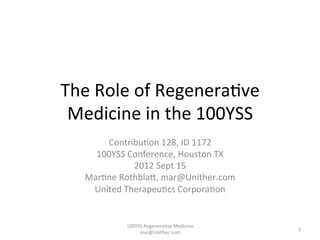Regen slideshow
- 1. The  Role  of  Regenera-ve   Medicine  in  the  100YSS   Contribu-on  128,  ID  1172   100YSS  Conference,  Houston  TX     2012  Sept  15   Mar-ne  RothblaF,  mar@Unither.com   United  Therapeu-cs  Corpora-on   100YSS  Regenera-ve  Medicine   mar@Unither.com   2  
- 2. Regenera-ve  Medicine  in  Film   100YSS  Regenera-ve  Medicine   mar@Unither.com   3  
- 3. Supernovas  (eg  Crab  Nebula)  èGalac-c  Cosmic   Rays,  With  The  Ejected  Protons  Ricoche-ng  Like   Billiard  Balls  Against  Galaxy’s  Magne-c  Field   100YSS  Regenera-ve  Medicine   mar@Unither.com   4  
- 4. Gamma  Rays  Produced  when  Ubiquitous  Galac-c   Cosmic  Rays  Interact  with  Interstellar  Medium  Reveals   100YSS  Regenera-ve  Medicine   mar@Unither.com   5  
- 5. Organ  Transplants  Extend  Life   100YSS  Regenera-ve  Medicine   mar@Unither.com   6  
- 6. 100YSS  Regenera-ve  Medicine   mar@Unither.com   7   In  Vivo  Organ   Regenera-on  Via   Stem  Cell   Transplanta-on   1st  Genera-on  iPS   Technology  
- 7. 100YSS  Regenera-ve  Medicine   mar@Unither.com   8   In  Vivo  Organ   Regenera-on  Via   Stem  Cell   Transplanta-on   2nd  Genera-on  iPS   Technology  
- 8. Transplantable  Differen-ated  iPS  Cells   100YSS  Regenera-ve  Medicine   mar@Unither.com   9  
- 9. In  Vivo  Liver  Regenera-on   100YSS  Regenera-ve  Medicine   mar@Unither.com   10  
- 10. 100YSS  Regenera-ve  Medicine   mar@Unither.com   11  
- 11. Rat  Lungs  Can  Be  Kept  Breathing  in  a   Fluid-­‐Air  System  for  a  Week   100YSS  Regenera-ve  Medicine   mar@Unither.com   12  
- 12. Decellularized  Pig  Lungs   100YSS  Regenera-ve  Medicine   mar@Unither.com   13  
- 13. Ex  Vivo  Organ  Regenera-on  for   Transplanta-on  (Pig  Lungs)   100YSS  Regenera-ve  Medicine   mar@Unither.com   14  
- 14. Human  Peripheral  Endothelial  Progenitor  Cells   Can  Be  Cultured,  Manipulated  &  SEEDED   Human  Umbilical  Vascular  Endothelial  Cells  Used  To  Date  100YSS  Regenera-ve  Medicine   mar@Unither.com   15  
- 15. Timeframe  Considera-on   •  Human  Lung  Has  About  109  Endothelial  Cells   •  Within  a  Month,  Endothelial  Progenitor  Cells   Found  in  Peripheral  Circula-on  Can  be   Cultured  to  Around  106         •  Doubling  Time  of  Around  30  Days   •  May  Require  About  a  Year  to  Grow  Lungs  for   Transplant  Once  Decide  to  Proceed   100YSS  Regenera-ve  Medicine   mar@Unither.com   16  
- 16. Xenogeneic   Organ   Regenera-on   17   100YSS  Regenera-ve  Medicine   mar@Unither.com  
- 17. Xenogeneic  Pigs  on  O’Neill  Habitat   100YSS  Regenera-ve  Medicine   mar@Unither.com   18  
- 18. hEPCR  hVWF   hCD73   pVWFKO   hTFPI  hTBM   hCD39   19   Coagulate   GP1b   GP2b3q   GTKO   hMCP   HLA-­‐E   hDAF   hMIRL   Immune   SIRP/ CD47   Lec-ns   Sialyda-on   Selec-ns   100YSS  Regenera-ve  Medicine   mar@Unither.com  
- 19. Da  Vinci  Surgical  Robot   100YSS  Regenera-ve  Medicine   mar@Unither.com   20  
- 20. Da  Vinci  Robots  Have  Now  Explanted   Livers  for  Transplanta-on   100YSS  Regenera-ve  Medicine   mar@Unither.com   21  
- 21. Robo-c  Transplanta-on  on  100YSS  of   Xenograis  or  Regen  Organs  Will  Be  Prac-cal     100YSS  Regenera-ve  Medicine   mar@Unither.com   22  
- 22. Just  Like  Shepard’s  May  1961  Flight   Was  <.1%  to  the  Moon   23   100YSS  Regenera-ve  Medicine   mar@Unither.com  
- 23. We  Can  Be  1000x  Further  Than   We  Are  In  Under  Ten  Years!   24   100YSS  Regenera-ve  Medicine   mar@Unither.com  























